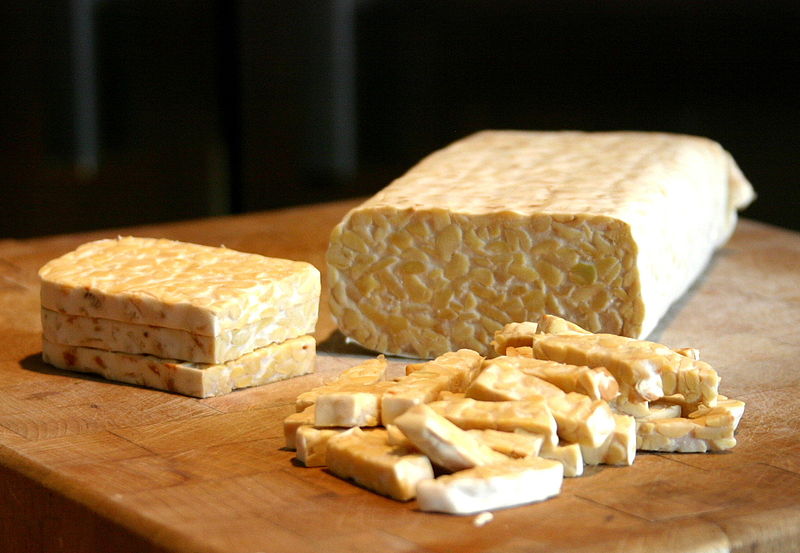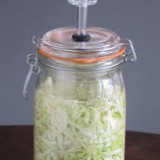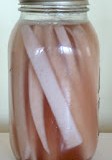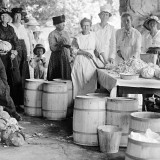 |
| Katz chats up Master Food Preserver and author Kevin West |
Last night Erik and I went to see a talk by fermentation guru Sandor Katz, hosted by the Environmental Changemakers. Being a huge Sandor Katz fangirl, I was thrilled to get a chance to see him in person. These days he’s sporting a charming 19th century mustache!
His first book, Wild Fermentation, was one of those really important, life-changing books for me. It might sound strange to say this about a book on pickling, but it opened my eyes in many ways. And it taught me how to do vegetable and salt ferments, which are the backbone of my pickling practice. The daikon pickles we wrote about in The Urban Homestead are due to Wild Fermentation.
Now he’s got a new book out, The Art of Fermentation, which I’ve got to get my hands on:
Here are some excerpts from my notes:
• For those of you who need convincing, The Four Benefits of Fermentation:
1) Pre-digestion: Fermentation makes foods more edible by breaking them down a little for us. Soybeans are hard to digest, tofu–easy. Milk is hard for some people to digest, but yogurt much easier, etc.
2) Nutrient Enhancement: These foods are rich in B vitamins as well as less known micronutrients, which are being studied right now. They also make minerals more available to us.
3) Detoxification: Some plant materials are downright toxic unless fermented, e.g. cassava root.
4) Live Bacterial Cultures: We need live bacteria in our gut– most especially lactobacillus. By eating these foods we renew and diversify our microbial armies.
And of course, fermentation is a preservation process. Today that aspect isn’t as important as it once was, but really, into the last century it was a survival skill.
And finally, it creates delicious, strong-flavored foods. Where would we be without stinky cheese, miso, sourdough, kimichi and kraut?
• He mentioned the Human Microbiome Project, which I’d never heard of but which I think we’ll have to blog on soon. Thank god someone is studying this stuff! He said they’re really bringing to the fore our deep and intimate relationship with bacteria.
• Because we drink chlorinated water and antibiotics are so grievously overused, we need to consciously replenish and diversify the bacteria in our guts by eating living foods like fermented vegetables and yogurt.
• Lacto-fermenting vegetables is a very safe practice. The FDA has no reports of anyone contracting a food borne illness from eating live kraut, kimchi, sour pickles, etc.
• Sandor encourages people who are interested in fermented/cultured foods to start with vegetable ferments — and I agree–it’s where we started! Vegetable ferments are safe, easy, require no special equipment or starter cultures. Here’s our daikon pickle recipe from way back in 2007. How did our blog get so old?
• Two kraut tips:
1) Don’t use juice from the last batch of kraut to inoculate a new batch. It works, but it tastes much better if you just start from scratch with salt and the bacteria present on the cabbage. He explained that any ferment goes through stages where different strains of bacteria rise to dominance and effect flavor–which is why ferments taste different at different stages. The juice from ripe kraut contains late-stage bacteria. By inoculating with that bacteria, you skip all the delicious, intermediate stages.
2) He encouraged us not to be afraid of old vegetable ferments. Say you’ve made a big batch of kraut or kimchi. To retard the fermentation process (i.e. stop it where you think it tastes good) you’ll want to pack it in jars and put it in the fridge. (You don’t want to heat-process your jars, because that will kill all the living bacteria). How long do you think a full jar of kraut or kimchi will last in the fridge? Sandor says two years is not unreasonable–as long as it is full. Airspace creates mold opportunities.
• “But I don’t like the flavor.”
One of the audience confessed she really doesn’t like the strong flavors of sauerkraut. Sandor explained that when making kraut, or any veg ferment, you can stop the process anywhere from say, 3 days to 3 months, depending on both your preferences and the ambient temperature. 3 day old kraut is very different than 3 month old kraut, but both are delicious living foods. I’d add that I agree. One of my favorite forms of kraut is a blend of red cabbage and green apples and caraway seeds which is fermented only for a few days. It’s still crisp and bright when you eat it, sort of like a fermented salad.
• One thing he said surprised me: he doesn’t think it matters at all what kind of salt you use. I’ve always used non-iodized salt for my ferments. But I’d bow to his greater experience. He did say that if you have it, and can afford it, high-mineral natural salts are fantastic to use.
• How much salt? That’s sort of a perennial question. For him, it’s a matter of taste. Other resources will give exact recommendations of salt per pound of vegetables. The more salt you use, the slower the fermentation will be, and the longer the end product will last. It will also, of course, be very salty. Less salty ferments go more quickly. He salts his kraut to taste. Simple as that.
• I was glad to hear him admit that cucumbers are the hardest thing to pickle!
• If you’re in the market for a ceramic crock, he pointed out that you can order one via Ace Hardware’s websiteand then pick it up at your local Ace.






Good to know that fermented foods last so long. I just found a jar of Kim chee in the fridge. I made it 6 months ago. It looks and smells fine but I wasn’t sure I should taste it. Guess I should sort out the fridge more often.
@Parsimony: I read your comment–then I clicked the “delete” button instead of the “publish” button. Sorry!!!!
The 1st time I made pickled cukes, they were quite mushy. (Tasty, and pretty good blended up & mixed into tuna salad, though…) Then I read about an enzyme in the blossom end of the cucumber that makes the pickles soggy, and for the second try, I used my husband’s grandmother’s trick. She seems to have sworn that cutting off the end off a cuke and rubbing the piece in small circles against the cut end of the fruit “draws out the bitterness”. Certainly, it can produce a somewhat soapy foam. I did this, washed off the foam, and had nice crunchy pickles.
Thanks for the tip!
An outstanding share! I’ve just forwarded this onto a friend who has been conducting a little research on this. And he actually ordered me dinner because I discovered it for him… lol. So let me reword this…. Thanks for the meal!! But yeah, thanks for spending time to talk about this topic here on your web page.